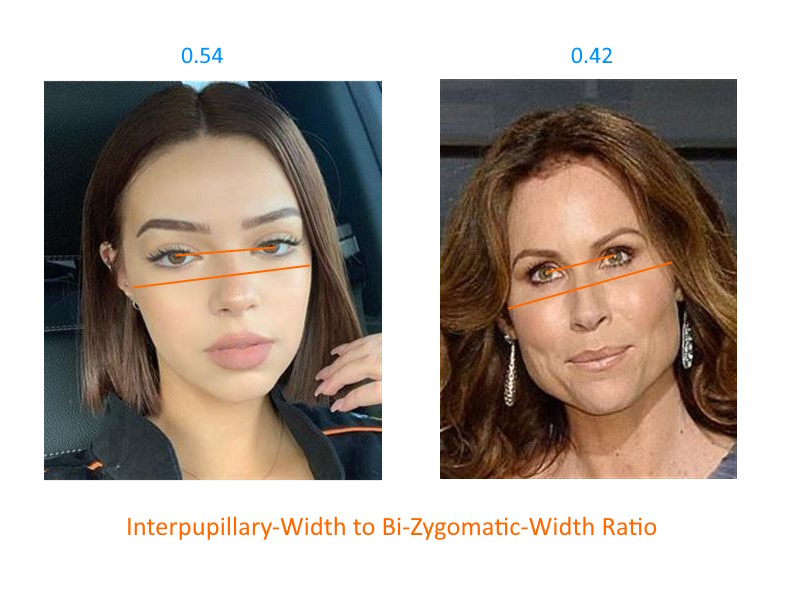Summary
Interpupillary Width is the distance between the centers of the pupils of the two eyes, while Bi-Zygomatic Width is the distance between the most prominent points of the cheekbones. A greater ratio of Interpupillary Width to Bi-Zygomatic Width results in the appearance of the eyes being larger in proportion to the rest of the face, which is considered attractive among females. This is because a larger eye area can be associated with youth, attractiveness, and innocence, and contributes to a more aesthetically pleasing and youthful appearance. Various factors, including eye size, distance between eyes, and cheekbone shape, can influence the size of the eye area.
Females find a larger Interpupillary-Width to Bi-Zygomatic-Width Ratio attractive as it contributes to a more expansive external orbital surface area. A research study asked 80 participants aged 30 to 50 years to evaluate the perceived age and attractiveness of female eye regions using digital images. The study authors referred to another study, which found that people tend to prefer faces with a larger soft tissue orbital area and youthful features, which supports the babyfaceness hypothesis of facial attractiveness proposed by Bashour (2006). This suggests that there is a natural tendency to perceive larger orbital areas and youthful features in the eye region as attractive.
Research
Interpupillary Width is the distance between the centers of the pupils of the two eyes. Bi-Zygomatic Width is the distance between the most prominent points of the cheekbones, also known as zygomatic bones. A greater interpupillary width in relation to the bi-zygomatic width can create the appearance of larger eyes with an appropriate distance between them.
A larger ratio of Interpupillary-Width to Bi-Zygomatic-Width Ratio results in the appearance of the eyes being larger in proportion to the rest of the face. In the context of facial features and aesthetics, a large eye area can be associated with youth, attractiveness, and innocence. The size of the eye area can be influenced by various factors, such as the size of the eyes themselves, the distance between the eyes, and the shape of the surrounding facial features, such as the cheekbones.
A larger ratio of Interpupillary-Width to Bi-Zygomatic-Width Ratio is considered attractive among females, as it contributes to a more expansive external orbital surface area. According to the study by Sforza et al. (2015), attractive young women and men had longer eye fissure lengths on both the right and left sides compared to individuals with average attractiveness. This increased length, along with a larger external orbital surface area, may create a more aesthetically pleasing and youthful appearance, which could be a contributing factor to perceived attractiveness.

Similarly, another research study was carried out by Prantl et al. (2019) where 80 probands participants aged 30 to 50 years were asked to evaluate the perceived age and attractiveness of female eye regions using standardized high-resolution digital images. The authors in the study pointed out the study by Sforza et al. (2015) in which it was noted that individuals tend to prefer faces with a larger soft tissue orbital area and juvenile features, which aligns with the babyfaceness hypothesis of facial attractiveness proposed by Bashour (2006). The preference for larger orbital areas and youthful features in the eye region may be indicative of an inherent inclination towards perceiving these characteristics as attractive.

References:
Sforza, C., Dolci, C., Grandi, G., Tartaglia, G. M., Laino, A., & Ferrario, V. F. (2015). Comparison of soft-tissue orbital morphometry in attractive and normal Italian subjects. The Angle Orthodontist, 85(1), 127-133. https://doi.org/10.2319/012814-75.1
Prantl, L., Heidekrueger, P. I., Broer, P. N., Knoll, S., Thiha, A., & Gründl, M. (2019). Female eye attractiveness–Where beauty meets science. Journal of Cranio-Maxillofacial Surgery, 47(1), 73-79.
https://doi.org/10.1016/j.jcms.2018.05.034
Bashour, M. (2006). History and current concepts in the analysis of facial attractiveness. Plastic and reconstructive surgery, 118(3), 741-756. 10.1097/01.prs.0000233051.61512.65

